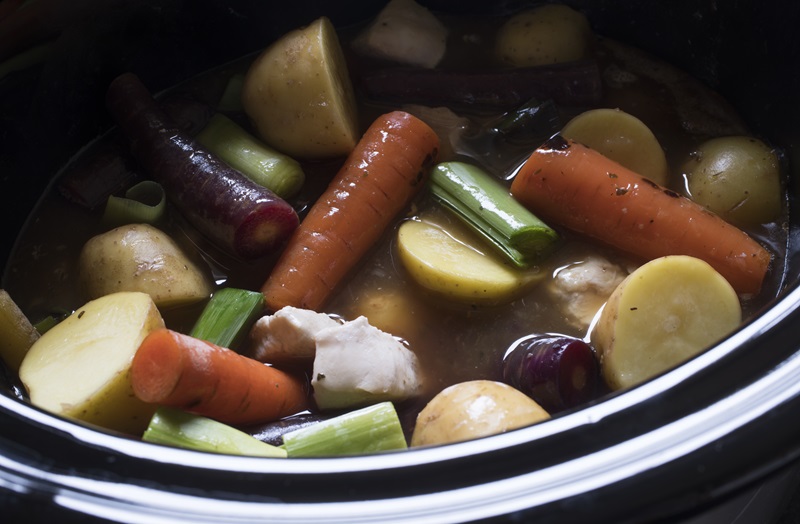Introduction to Slow Cookers
What is a Slow Cooker?
A slow cooker, also known as a crockpot, is a kitchen appliance designed to cook food slowly over a long period of time. It consists of a removable pot, usually made of ceramic or porcelain, and a heating element that surrounds the pot. The slow cooker operates at a low temperature, allowing for a gentle and gradual cooking process.
The beauty of a slow cooker lies in its simplicity. All you need to do is prepare your ingredients, place them in the pot, set the desired temperature and cooking time, and let the slow cooker work its magic.
Advantages of Using a Slow Cooker
The long, slow cooking process allows the flavors to meld together, resulting in rich and delicious meals. It’s especially great for tenderizing tough cuts of meat. Slow cookers are also energy-efficient. They use less electricity than traditional ovens or stovetops, making them a cost-effective option for cooking meals. They’re also pretty versatile, and can be used to make a wide range of dishes, from soups and stews to roasts and desserts.
Preparing Ingredients for Slow Cooking
Choosing the Right Cuts of Meat
As mentioned earlier, tougher cuts of meat, like beef chuck, pork shoulder, or lamb shanks, are ideal for slow cooking. These cuts have more connective tissue and collagen, which break down and become tender during the long cooking process.
Leaner cuts, like chicken breasts or pork tenderloin, can dry out in the slow cooker, so it’s best to use them sparingly or in combination with fattier cuts. Remember to trim excess fat before cooking to prevent greasiness in the final dish.
Preparing Vegetables for Optimal Slow Cooking
Vegetables play a vital role in slow cooking, adding flavor, nutrients, and texture to your dishes. Start by cutting them into uniform sizes to ensure even cooking. Root vegetables like potatoes, carrots, and turnips can withstand long cooking times, so feel free to chop them into larger chunks. However, more delicate vegetables, like zucchini or bell peppers, should be added towards the end of the cooking process to prevent them from becoming mushy. For added flavor, sautéing or caramelizing onions and garlic before adding them to the slow cooker can enhance the overall taste of your dish.

Time-Saving Tips
Prepping Meals in Advance
To maximize efficiency, dedicate a portion of your day to chopping and prepping ingredients for multiple meals. This way, you can simply dump everything into the slow cooker when you’re ready to cook. Consider investing in some good quality storage containers to store your prepped ingredients in the refrigerator until you’re ready to use them. This not only saves time but also ensures that you have healthy and delicious meals ready to go.
Utilizing Slow Cooker Liners for Easy Cleanup
Nobody enjoys scrubbing a dirty slow cooker after a delicious meal. To make cleanup a breeze, try using slow cooker liners. These disposable liners fit neatly into your slow cooker and prevent food from sticking to the sides or bottom. Simply place a liner in the slow cooker before adding your ingredients, and once your meal is cooked, you can easily lift out the liner and discard it, leaving your slow cooker virtually mess-free. Slow cooker liners are easily available in stores or online, and they can be a game-changer when it comes to simplifying your cleanup routine.
Efficient Cooking Techniques
Layering Ingredients for Even Cooking
When it comes to using a slow cooker, properly layering the ingredients is key to achieving even cooking throughout your dish. Start by placing the tougher and larger ingredients, such as root vegetables or meat, at the bottom of the slow cooker. This ensures that they receive the most direct heat and have enough time to fully cook.
Next, add any softer ingredients, like leafy greens or delicate vegetables, on top of the sturdier ones. This prevents them from becoming overcooked. Remember to evenly distribute any liquids or sauces to help with the cooking process.
Adapting Recipes for Different Slow Cooker Sizes
If your slow cooker is smaller than the one specified in the recipe, you may need to reduce the quantities of ingredients to ensure they fit and cook properly. On the other hand, if you have a larger slow cooker, you might need to increase the amounts to fill the pot adequately and prevent overcooking. Keep in mind that cooking times may also vary depending on the size of your slow cooker. It’s always a good idea to check for doneness by testing the dish with a fork or thermometer.



